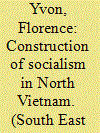| Srl | Item |
| 1 |
ID:
120629


|
|
|
|
|
| Publication |
2013.
|
| Summary/Abstract |
The acceleration of urban expansion has greatly impacted the study of China's urban system, and the urban function at the national level has largely been characterised by the spatial distribution and evolution of cities. In order to understand the dynamics of urban development in China, it is necessary to analyse the history of city evolution and understand the context in which that evolution took place. The first section of this paper introduces the urbanisation process in China since the 1950s in order to demonstrate the origins of China's recenturbanisation patterns. Subsequently, the structural transitions of city scaling and urban clusters are presented by employing Rank-size Analysis and satellite imagery, followed by the challenges brought about by these changes. Finally, the spatial distribution and transition patterns of China's urban system are analysed using Centrographic Analysis.
|
|
|
|
|
|
|
|
|
|
|
|
|
|
|
|
| 2 |
ID:
081542


|
|
|
|
|
| Publication |
2008.
|
| Summary/Abstract |
This paper examines the process of transformation of domestic trade in the early independent Democratic Republic of Vietnam, focusing on the grain sector. It argues that, after the severe food crisis of the spring of 1955, the regime called for structural changes and tried to establish a predominant socialist trade system, without however resorting to a state monopoly, but failed to implement the new institutions of socialist trade. The study further shows that this failure, together with other domestic policy issues, compelled the leaders of the DRV to tolerate de facto until about the second half of 1959 a modus vivendi between the state grain sector and the private economic actors. It also demonstrates that these institutional arrangements and innovative procurement policies were in fact quite successful: the food supplies, sold through the public distribution system and the market channels, were on the whole adequate; and the state procurement of paddy increased noticeably. However, because of heated debates in the Political Bureau, partly due to the failure of the state policy, this compromise came to an abrupt end in April 1959 and was followed by a rapid and drastic shift towards the construction of socialism. As a result, private trade had practically disappeared by the end of 1960.
|
|
|
|
|
|
|
|
|
|
|
|
|
|
|
|